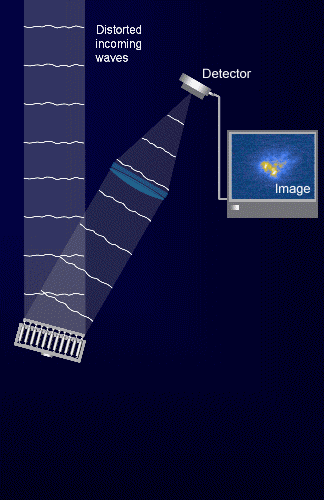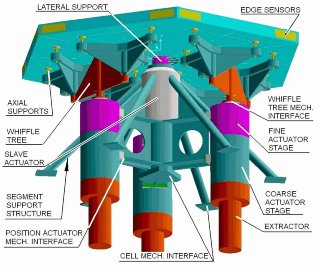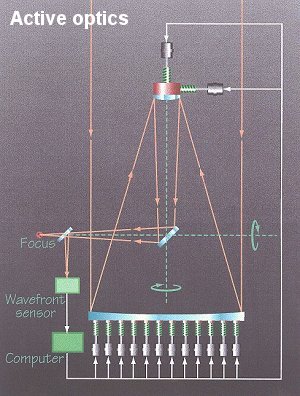|
|
|
 Last
modified: 2004/07/09 Last
modified: 2004/07/09
| OWL
- FREQUENTLY ASKED QUESTIONS |
| |
|
|
| WHERE WILL
OWL BE LOCATED ? |
|
|
| |
 |
 |
| |
Clear sky is not enough -
the sites of modern observatories are chosen according
to numerous criteria.
|
The nest for OWL has not been selected yet and a world-wide
search is under way, scrutinizing the many parameters relevant
to the performance and cost of an Extremely Large Telescope
(ELT): atmospheric properties (cloud cover, brightness, turbulence
strength, speed and height distribution, water vapor content),
geography (access and utilities cost, earthquakes, soil resistance),
etc. Prominent candidates include areas close to ESO's observatories
La Silla and Paranal, in the Chilean Atacama desert, as well
as the site of the Roque de los Muchachos on the island of
La Palma (Canary Islands). Other possible candidates are being
evaluated too, including but not limited to sites in Argentina,
the Atlas and even particularly performing -and demanding-
locations near or at the South Pole. To the possible extent,
site selection will also take into account potential long-term
climate variability.
|
|
|
| |
| The total estimated cost of OWL is about 1,200
millions of Euros, including 940 million Euros in capital investment.
This figure is however provisional, as the conceptual design
phase and relevant industrial studies are still in progress.
At the time being, major cost positions (structural mechanics
and optical subsystems) have already been addressed by way of
competitive industrial studies. |
| WHEN WILL
IT BECOME OPERATIONAL ? |
|
|
| |
|
Because of its modular design the telescope could become
operational before full completion. Once the telescope structure
and the enclosure are completed and the essential control
systems integrated, the telescope is basically "growing"
at the pace of integration of the segments.
The project is still in an early phase and at the time being
funding is secured for studies only, not for construction.
ESO is currently reviewing its options, with a view to identifying
possible paths towards the final design and construction of
a 60- to 100-m OWL.
Taking into account plausible funding schemes as well as
technical considerations, and making generous allocations
for engineering work in the first phases of segments integration,
OWL could start science operation as a 60-m class telescope
by 2016-2017, with full 100-m capability by 2020. A faster
schedule would be possible with early funding.
|
| |
| WHAT
IS THE BENEFIT OF LARGER TELESCOPES ? |
| |
| The diameter of a telescope is its key performance
characteristic. A larger telescope will collect more light,
in proportion to its collecting area hence to the square of
its diameter, and concentrate it in images whose sharpness (or
resolution) is also proportional to the diameter. In brief,
a telescope of 100-m will collect 100 times more light than
a 10-m one, and have an angular resolution 10 times better.
In practice, imperfect reflectivity or throughput of the optics
will imply some losses of light, while atmospheric turbulence
and residual telescope errors will limit the resolution. Still,
the larger the better. |
| |
| HOW
DOES OWL COMPARE WITH SPACE TELESCOPES ? |
|
|
| |
|
In view of their cost and specific constraints, future space
and ground observatories are likely to complement rather than
compete. Observing from the ground imposes two main limitations.
The first is the blurring effect of atmospheric turbulence,
which degrades angular resolution much beyond the theoretical
limit, even on the best astronomical sites. The second is
the limited transparency and relatively high brightness of
the atmosphere at certain wavelengths of light.
The first limitation can be overcome with adaptive optics,
a technique that allows real-time compensation of the blurring
effect of the atmosphere. Indeed, the best astronomical images
in terms of resolution are now taken from ground rather than
from space, and all current and future telescope projects
incorporate adaptive systems, which come at a tiny fraction
of the cost of a space telescope. Still, the current generation
of adaptive optics systems are limited to observations in
the near-infrared, with a small field of view and constraints
on target selection. A second, more powerful and versatile
generation is under development, with first results expected
by 2005.
As for the second limitation, there does not seem to be any
physical way to overcome it. As a result, space telescopes
are a must at those wavelengths where the atmosphere isn't
dark or transparent enough, e.g. in the X-ray and far-infrared
domains. In the visible to near-infrared, a large space observatory
like the 6.5 m diameter JWST, unhindered by the absorption
and emissivity of the atmosphere, will have a superior ability
to detect new classes of astrophysical objects, while a 100-m
diameter OWL, with its much larger light collecting power
and at a significantly lower global cost, will provide deep
physical identification through spectral analysis.
|
| |
| HOW
CAN OWL ACHIEVE THE SAME RESOLUTION AS IF IT WERE IN SPACE ? |
| |
|
The light waves collected by ground-based telescopes are
inevitably distorted by atmospheric turbulence, thus preventing
these telescopes to reach their theoretical resolution, no
matter what their intrinsic quality is.
| |
 |
 |
Schematic principle of adaptive
optics. The distorted wave is shown after propagation
through the atmosphere and the telescope.
|
The theoretical resolution is best expressed as the sharpest
angle beyond which a telescope will no longer be able to deliver
a meaningful image contrast, and is given in radians by the
ratio l/D, with l
the wavelength of light and D the telescope diameter. Hence
an 8-m telescope should be able to resolve objects down to
0.013 arc seconds at visible wavelength (l=0.0005
mm). Yet because of atmospheric turbulence, images taken from
good astronomical sites have a typical resolution of 0.5 to
1.0 arc seconds, occasionally better when the conditions are
optimal.
The most evident solution to this problem is to place the
telescope in orbit. This is, however, a very expensive one,
and it has its own drawbacks - such as reduced lifetime, difficult
or impossible maintenance and upgrades, etc. Another is to
fit the ground-based telescope with an adaptive optics
system. It essentially consists of one or several active
components (deformable mirror), a metrology system (wavefront
sensor) and a fast computer. The metrology system picks up
the light of a reference star in the field, and measures the
distortions of the incoming wave. This measurement is translated
into commands sent by the computer to actuators supporting
the deformable mirror, whose shape is eventually adjusted
so as to compensate the distortions of the wave. This correction
must be repeated continuously -in practice hundredth of times
per second, turbulence being rapidly changing.
As a result, the blurring effect of the atmosphere is cancelled
out -at a tiny fraction of the cost of a space telescope.
This technique has been successfully integrated into quite
a number of existing ground-based telescopes, allowing them
to deliver unrivalled images. Yet it still has crucial limitations.
Turbulence changes with direction, hence images can be corrected
over a rather small field of view only; a reference star must
be found close enough to the science target, and must be bright
enough to allow its light to be collected and analyzed within
a few milliseconds. Second generation adaptive systems, with
enhanced capabilities, are under construction and should enter
in operation on 8-m class telescopes within the next years.
|
| |
| WHAT
IS A MILLI-ARC SECOND RESOLUTION ? |
|
| |
|
Rigorously speaking, the term "resolution" is related
to the ability of an optical system to render contrast in
the image of complex objects. In astronomy, it is also often
used to characterize the sharpest angle under which two point-like
sources will still be separated into individual ones. A milli-arc
second is the angle under which two sources separated by one
meter would be seen, if placed at a distance of about 200,000
km from the observer.
The theoretical resolution of a telescope is given in radians
by the ratio l/D, with l
the wavelength of light and D the telescope diameter. With
visible light (l~0.0005 mm) a 100-m
telescope should be able to reach a resolution of 0.000000005
radians, i.e. 0.00000028 degrees or 1/1000th of an arc second.
|
| |
| HOW
FAINT WILL IT SEE ? |
| |
|
OWL will be able to reach magnitude 38 in 10 hours exposure
time. This is a factor five thousand billion (5,000,000,000,000)
fainter than the faintest star visible to the naked eye.
|
| |
| HOW
IS THE OPTICS MADE ? |
| |
|
The primary and secondary mirrors will be made of hexagonal
segments, 1.6-m flat-to-flat (diameter of the inscribed circle).
The primary mirror is spherical, made of 3042 all-identical
segments. The secondary mirror is flat, with 216 all-identical
segments.
The segments will be made of low-expansion glass or glass-ceramic.
Lightweight silicon carbide is considered as a promising alternative,
and a development programme is under way to validate the technology.
The segments will be polished on conventional lapping machines,
their simple spherical or flat figure allowing cost- and quality-effective
processes.
The required production rate is about 1.5 segments per day.
Although impressive by the standards of astronomical production,
this high rate is within reach of properly industrialized
production. Because of the simple, all-identical spherical
or flat figure and of the relatively modest dimensions of
individual segments, the process yield and the necessary investments
are reliably predictable. This has been confirmed by European
suppliers under ESO contract.
|
| |
| WHY
NOT A CLASSICAL OPTICAL DESIGN ? |
| |
|
The optical design is constrained by five essential requirements:
- The telescope length, hence the primary mirror focal ratio,
must be minimized to allow reasonable stiffness and keep
enclosure dimensions to the minimum required.
- The field and optical quality requirements call for proper
correction of aberrations in the 10 arc minutes field of
view.
- The design must incorporate suitably located optical surfaces
to perform the required functions (active optics, field
stabilization, adaptive optics).
- Large deflections under gravity and wind load are inevitable
in viiew of the structure size and therefore, designs sensitive
to misalignments should be avoided, or at least cirtical
surfaces placed at locations where high structural stiffness
can be realized.
- Cost, which, in addition to other system considerations,
restricts the shape of the primary mirror to that permitted
by a cost-effective fabrication process.
These constrains virtually rule out classical two-mirrors
solutions and alternatives must be explored. Solutions with
spherical primary and secondary mirrors become particularly
attractive in view of the manufacturing, maintenance and cost
benefits of all-identical segments.
|
| |
| HOW
ARE THE SEGMENTS KEPT ALIGNED ? |
| |
| . |
 |
| |
Individual segments are permanently
re-adjusted in position. |
| |
|
Segments must be aligned to within a fraction of the wavelength
(0.0005 mm for visible light) in order for the telescope to
deliver acceptably good images. Such tolerance cannot be met
passively and the segments must be permanently re-adjusted in
position, up to a few times per second to cope with e.g. mounting
imperfections, flexures, thermal changes, wind buffeting. To
this end, the segments are mounted onto a support system that
distributes their weight onto an even distribution of supports.
Those are connected to three position actuators that
allow re-positioning of the segment down to a few nanometre
accuracy. Minute misalignments are measured by position or
edge sensors (e.g. capacitive, inductance-based or optical)
located between segments; the measurements are fed back into
a computer that calculates the necessary re-adjustments and
sends appropriate commands to the actuators. The sensors must
be periodically calibrated; this is done with a phasing
sensor located at the focus of the telescope, and which
uses the light of a star outside the science field to produce
an image of the segmented mirror in order to detect, in one
way or another, diffraction effects associated with segments
local misalignments. There are several possible types of phasing
sensors. That used in the Keck telescopes should theoretically
work with up to ~4000 segments; others (curvature, pyramid,
and Mach-Zehnder sensors) have been shown to work in laboratory
experiments and are being developed for on-sky testing. |
| |
| WHAT
IS ACTIVE OPTICS ? |
| |
| . |
 |
| |
Modern telescopes are re-optimized
in real time during operation. |
| |
|
Active optics, pioneered by ESO in the mid-1980s with its
3.5-m New Technology Telescope (NTT), is a concept that allows
the actual quality of a telescope to be re-optimized in real
time.
In the NTT, the secondary mirror is supported by a kinematic
mount that allows to center it and focus the telescope as
needed. In addition, the primary mirror is mounted on force
actuators (which could be conceived as motor-driven "springs")
in order to adjust its shape by applying suitable force distributions.
Doing so not only allows the optical quality to be kept optimal,
it also allows -even require- the primary mirror to be flexible
-hence thin, easier to cast and less expensive. It also simplifies
the work of the optical manufacturer, as fabrication tolerances
are greatly relaxed, residual errors being automatically compensated
by appropriate adjustments of support forces.
The primary mirror support correction forces and secondary
mirror motion are calculated on the basis of measurements
provided by a wavefront sensor located at the focus
of the telescope. This sensor picks up the light of a star
outside the science target, so as not to disturb the observation,
the image of this star is analyzed and appropriate commands
sent to the secondary mirror kinematics and primary mirror
active supports. Active optics has shown its excellent potential
and robustness in the NTT and more recently in the 8-m VLT
telescopes, which routinely deliver images truly limited by
the site turbulence.
|
| |
| WHY
A LIGHTWEIGHT DESIGN ? |
| |
| - |
 |
| |
Overweight troubles |
| |
|
It may seem far fetched to call a 14,800 metric tons moving
structure a lightweight one. Yet with 1/50th to 1/100th the
mass of current 8-m telescopes if they were scaled to 100-m
dimensions, OWL is a very lightweight design indeed. Yet its
stiffness, as measured by its first eigenfrequency (2.6 Hz)
is comparable to that of existing 4-m class telescopes.
Mass saving is not only a matter of lower material costs.
It has positive impacts at almost every level of the system
design, in terms of performance, safety and costs. Eliminating
unnecessary structural masses reduces flexures and stresses,
implies less powerful drives, relaxes requirements for the
concrete foundations, reduces transient thermal distortions,
and simplifies integration.
|
| |
| WHAT'S
IN A NAME ? |
| |
| Though often confused with a sign of the hubris
of astronomers, the OWL (OverWhelmingly Large) acronym is
in a fact an ironic reference to the present generation of "Very
Large", and even "Extremely Large" telescopes.
If budgetary considerations will force the final OWL to be smaller
than 100-m, it may eventually mean Originally Was Larger
... |
 |
|

